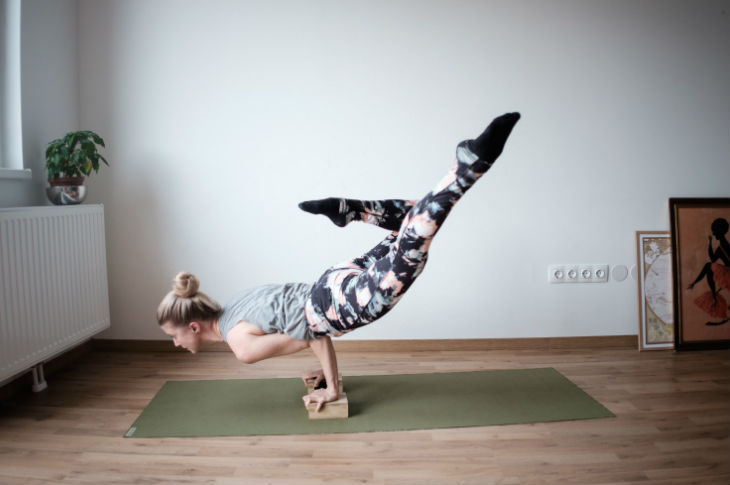
If you’re a gym-goer, it may feel like you’ve run out of options lately. Most gyms are closed, some with no signs of reopening anytime soon; many sporting goods stores are also, although some may be reopening for curbside pickup. If you’ve tried to find a set of dumbbells or other exercise equipment online, you may have run into a few snags with shipping delays or lack of availability.
The good news is that even amidst all of these obstacles, you can still get in a decent workout. For instance, some exercises don’t require any equipment at all. “You can create some pretty taxing circuits with basically anything that uses your body weight against gravity,” says Jessica O’Connell, a Canadian Olympic track and field athlete who co-founded the online athletic training company Grit Coaching with professional obstacle runner Faye Stenning. Burpees, bear crawls, jumping jacks, and planks are all viable options right in your living room (or bedroom, or basement, or backyard). Even shoes are optional!
To go beyond bodyweight exercises, however, you’ll have to get creative and start repurposing things you already own. The following list of household items can double up as workout equipment: You can mix, match, and definitely add to the list!
Firm chair as a weight bench. You won’t be able to lie down for bench presses or skull crushers (you’re better off laying on the floor to do these), but an uncushioned chair can work well for other “weight bench” exercises. Bent-over single-arm rows and tricep dips are two examples, and you can also prop your feet up for things like decline push-ups or Bulgarian split squats. However, for step-ups, O’Connell recommends using a regular stair, for safety purposes.
Couch cushion as a BOSU. If you’re not familiar with a BOSU, it’s the item in the gym that looks like an exercise ball (or “Swiss ball”) cut in half. You use it to engage all those little muscles you need for stability and balance. Try a couch cushion to replicate this unstable surface for exercises like lunges, squats, and push-ups.
Gallon jugs as kettlebells. Buy a gallon of water—or use an empty gallon of milk—and you suddenly have a do-it-yourself kettlebell. (Clean laundry detergent jugs are another option.) Start by filling the jug with water; according to O’Connell, if you fill it to the top, a gallon of water weighs just over eight pounds or three-and-a-quarter kilograms.
Then, if you want more weight, she suggests filling the jug with gravel. Sand and loose change are two other options, depending on what you have on hand. Just remember that unlike a kettlebell, the contents in your jug can shift or slosh, so be sure that you’re engaging your core when you try this.
A variety of different household items as weights. When it comes to weights, there are a lot of options depending on (a) the exercise you’re trying to do and (b) how much weight you want. For instance, if you’re looking to do a tricep extension where ordinarily you’d lower a dumbbell behind your head, a cast-iron skillet is a great substitute for the dumbbell, because it has a handle that’s easy to grip. A standard 12” skillet typically weighs around eight pounds, so depending on size, yours will probably weigh between four and twelve pounds.
Here are some other weight substitutes:
Very light weights: canned goods (which are sold by weight, so just remember that 16oz = one pound)
Light weights: full water bottles (remember: you can fill them with sand or coins to increase the weight)
Medium weights: hardcover textbooks, wine bottles (which, if they’re screw-tops, you can fill)
Heavy weights: reusable shopping, canvas tote bags, duffle bags, backpacks, or suitcases, all of which you can fill with items (clothing, canned goods, or books, depending upon desired weight)
Dish towels as sliders. Sliders or “gliding discs” look like small, flat frisbees that you use to slide across a smooth surface with your hands and feet. O’Connell recommends dish towels or socks as substitutes on a hardwood or tile floor. “Training might not look like it normally does,” she acknowledges. “But there are probably pieces of your training that you’ve neglected, like mobility or stabilization muscles.” Slider exercises are ideal for working on these types of weaknesses. Popular moves include knee tucks, mountain climbers, curtsey lunges, and plank jacks.
The bottom line is that while you might not be able to train the exact way you want to, you shouldn’t give up. “People take breaks all the time and come back fitter,” says O’Connell. “Doing something versus nothing makes that substantially easier.”
Consult your doctor before engaging in any of the above exercises, especially if you are prone to injuries, are pregnant or nursing, or have any other unique or special medical conditions. Substitute equipment is not a substitute for using proper form and safety precautions, and if you experience discomfort or a medical emergency, stop and consult with a medical professional.
This information is for educational purposes only and is not intended as a substitute for medical diagnosis or treatment. You should not use this information to diagnose or treat a health problem or condition. Always check with your doctor before changing your diet, altering your sleep habits, taking supplements, or starting a new fitness routine.

If you have questions about a Fitbit tracker, product availability, or the status of your order, contact our Support Team or search the Fitbit Community for answers.
Please note: Comments are moderated and may not appear immediately after submission.